
The Experimental Aircraft Association (EAA) is an international organization of aviation enthusiasts based in Oshkosh, Wisconsin. Since its inception, it has grown internationally with over 200,000 members and nearly 1,000 chapters worldwide. It hosts the largest aviation gathering of its kind in the world, EAA AirVenture Oshkosh.

Homebuilt aircraft, also known as amateur-built aircraft or kit planes, are constructed by persons for whom this is not a professional activity. These aircraft may be constructed from "scratch", from plans, or from assembly kits.
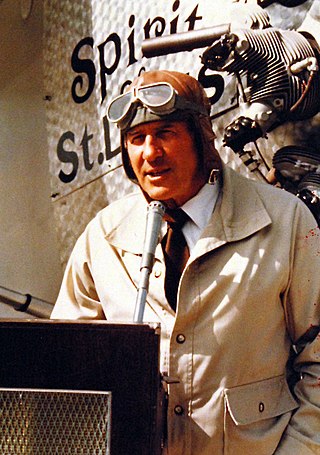
Paul Howard Poberezny was an American aviator, entrepreneur, and aircraft designer. He founded the Experimental Aircraft Association (EAA) in 1953, and spent the greater part of his life promoting homebuilt aircraft.
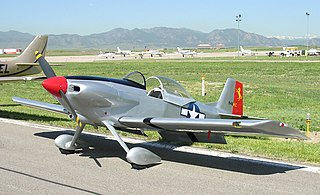
The Van's RV-3 is a single-seat, single-engine, low-wing kit aircraft sold by Van's Aircraft. Unlike many other aircraft in the RV line, the RV-3 is only available as a tail-wheel equipped aircraft, although it is possible that some may have been completed by builders as nose-wheel versions. The RV-3 is the genesis design for the rest of the RV series, all which strongly resemble the RV-3. The RV-4 was originally developed as a two-seat RV-3.

The EAA Aviation Museum, formerly the EAA AirVenture Museum, is a museum dedicated to the preservation and display of historic and experimental aircraft as well as antiques, classics, and warbirds. The museum is located in Oshkosh, Wisconsin, United States, adjacent to Wittman Regional Airport, home of the museum's sponsoring organization, the Experimental Aircraft Association (EAA), and the organization's EAA AirVenture Oshkosh event that takes place in late July/early August.

Aircraft fabric covering is a term used for both the material used and the process of covering aircraft open structures. It is also used for reinforcing closed plywood structures. The de Havilland Mosquito is an example of this technique, as are the pioneering all-wood monocoque fuselages of certain World War I German aircraft like the LFG Roland C.II in its wrapped Wickelrumpf plywood strip and fabric covering.

Flabob Airport is a small public-use airport located in Jurupa Valley, California, United States, in Riverside County, seven nautical miles (11 km) northwest of the central business district of Jurupa Valley, California.

The Stits SA-3A Playboy is a single seat, strut-braced low-wing monoplane that was designed by Ray Stits for amateur construction. The aircraft was designed and the prototype was completed in a three-month period during 1952. The design went on to become one of the most influential in the post-war boom in aircraft homebuilding.
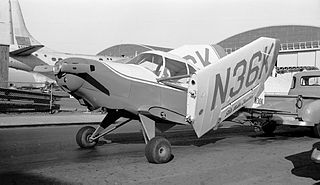
The Stits-Besler Executive is a three place homebuilt aircraft designed by Ray Stits, as the Stits SA-4A Executive.

The Stits SA-7 Skycoupe is a two-seat, side-by-side seating, high wing homebuilt aircraft designed by Ray Stits.

The P-5 Pober Sport is an early low-wing homebuilt aircraft designed by Experimental Aircraft Association founder Paul Poberezny. The one example built was flown across the country to every EAA chapter at the time.

The Florida Air Museum, formerly known as the International Sport Aviation Museum and the SUN 'n FUN Air Museum, is designated as Florida's "Official Aviation Museum and Education Center." It features a display of aircraft including one-of-a-kind designs, classics, ultra-lights, antiques and warbirds.
The Coser-Oonk CO-2 "Our Lady" is a single-place, open-cockpit, low-winged monoplane homebuilt aircraft design.
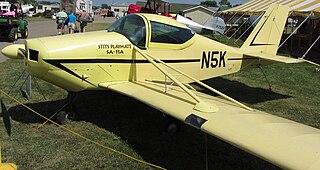
The Stits SA-11A Playmate is a homebuilt aircraft design that features a rapid wing-folding mechanism for trailering or storage.
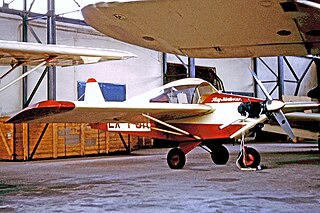
The Stits SA-5 Flut-R-Bug is a homebuilt aircraft designed by Ray Stits.
Richard E. "Dick" VanGrunsven is an American aircraft designer and kit plane manufacturer. The number of VanGrunsven-designed homebuilt aircraft produced each year in North America exceeds the production of all commercial general aviation companies combined.

The RV-1 is a Stits Playboy that was constructed with modifications by Richard VanGrunsven. The aircraft was the first of a series of Van's aircraft that became the most popular homebuilt aircraft produced.

The Stits SA-2A Sky Baby was a homebuilt aircraft designed for the challenge of claiming the title of "The World's Smallest".

The Stits DS-1 Baby Bird is a homebuilt aircraft built to achieve a "world's smallest" status. The Baby Bird is in the Guinness Book of World Records as the “Smallest Airplane in the World.” as of 1984. The title was later defined as "world's smallest monoplane" to acknowledge Robert H. Starr's Bumble Bee II as the world's smallest biplane.
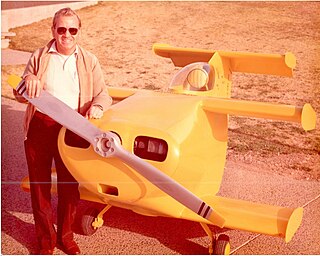
Robert H. Starr was the designer, builder and pilot of The World's Smallest Piloted Biplane Airplane, the Starr Bumble Bee II. The Guinness Book of Records awarded The Bumble Bee the official world record title in 1985 and with the flight of the Bumble Bee II, the record still stands today 2022.























